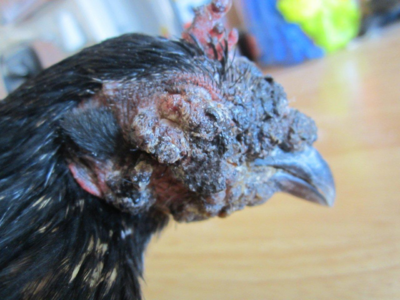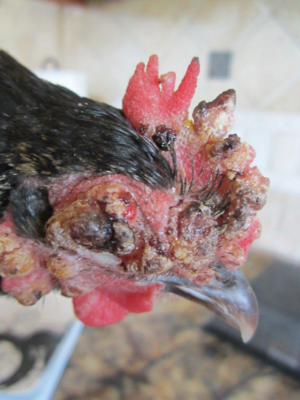Fowl Pox can affect many species. This includes wild birds, pigeons, turkeys, ducks, pheasants, quail, and, obviously, chickens. This disease could cause death in majorly infected birds, but it more often can cause weight loss, a decline in egg production, and poor/slower growth.
Fowl pox has two different strains: Dry pox and wet pox. Dry pox is much more common. Dry pox causes lesions on bare areas of chicken, such as comb, wattles, around the eyes, legs, feet, and otherwise featherless areas of the chicken. These lesions begin as small blisters and grow into large wart-like growths. When dry pox is in its first stages, the spots look like small, yellow bumps. Dry pox often changes color as the pox grows larger. The pox eventually looks like a scab covered bump, and when the scab falls off, it contains the pox virus which is highly contagious to other birds.

Photo of dry pox.
Wet pox also has lesions, but they are found in the oral cavity, trachea, larynx, and on the mucous membranes. Depending on the severity, wet pox can have a much higher mortality rate. Wet pox begins looking like small, white bumps and may grow into cheese colored lumps. These growths can get to the point where the bird has difficulty eating and drinking.

Photo of wet pox (this chicken has dry and wet pox)
Fowl pox is most commonly spread to flocks through biting mosquitos. A mosquito carrying the fowl pox virus can keep spreading it for eight weeks. Birds of any age can get fowl pox, and it can be spread or contracted during any time of the year.
The virus is present in dried scabs, feathers, and skin dander and can infect birds by entering through cuts and skin abrasions, commonly through fighting or pecking.
Signs of the fowl pox (both wet and dry strains) include:
How to prevent fowl pox:
Other information:
Fowl pox can not be spread to humans. Fowl pox is slow spreading, and as stated above, if a vaccine is given to the flock that does not have fowl pox, it can reduce the spread.
The link below is a good source for more information regarding fowl pox and other problems in chickens, and how to identify them:
https://www.backyardchickens.com/articles/identifying-your-birds-problem-from-home.74637/
I have only dealt with fowl pox three times. The first, it was a Cornish x meat bird, and it did not spread to any of my other birds. The second time it was another Cornish x, and it did not spread. Lastly, and the most recent, I bought a new hen who had fowl pox in the later stages (it was just one pox with a scab on it) and it has gone away, and again it did not spread.
Any poultry or waterfowl can have both wet and dry pox at the same time. The photos above is a chicken that has wet and dry pox. All pictures are courtesy of casportpony.


Fowl pox has two different strains: Dry pox and wet pox. Dry pox is much more common. Dry pox causes lesions on bare areas of chicken, such as comb, wattles, around the eyes, legs, feet, and otherwise featherless areas of the chicken. These lesions begin as small blisters and grow into large wart-like growths. When dry pox is in its first stages, the spots look like small, yellow bumps. Dry pox often changes color as the pox grows larger. The pox eventually looks like a scab covered bump, and when the scab falls off, it contains the pox virus which is highly contagious to other birds.
Photo of dry pox.
Wet pox also has lesions, but they are found in the oral cavity, trachea, larynx, and on the mucous membranes. Depending on the severity, wet pox can have a much higher mortality rate. Wet pox begins looking like small, white bumps and may grow into cheese colored lumps. These growths can get to the point where the bird has difficulty eating and drinking.
Photo of wet pox (this chicken has dry and wet pox)
Fowl pox is most commonly spread to flocks through biting mosquitos. A mosquito carrying the fowl pox virus can keep spreading it for eight weeks. Birds of any age can get fowl pox, and it can be spread or contracted during any time of the year.
The virus is present in dried scabs, feathers, and skin dander and can infect birds by entering through cuts and skin abrasions, commonly through fighting or pecking.
Signs of the fowl pox (both wet and dry strains) include:
- Scabs or wart-like lesions on the comb, wattles, eyelids, face, and feet
- Eyelid swelling and eyes sealed shut or scabbed over
- Yellow canker lesions in the mouth
- Weight loss
- Loss of appetite
- Reduced water intake
How to prevent fowl pox:
- Quarantine new flock members.
- Control mosquitos, if possible. (Bug spray, citronella candles, tiki torches, etc.)
- Vaccinating.
Other information:
Fowl pox can not be spread to humans. Fowl pox is slow spreading, and as stated above, if a vaccine is given to the flock that does not have fowl pox, it can reduce the spread.
The link below is a good source for more information regarding fowl pox and other problems in chickens, and how to identify them:
https://www.backyardchickens.com/articles/identifying-your-birds-problem-from-home.74637/
I have only dealt with fowl pox three times. The first, it was a Cornish x meat bird, and it did not spread to any of my other birds. The second time it was another Cornish x, and it did not spread. Lastly, and the most recent, I bought a new hen who had fowl pox in the later stages (it was just one pox with a scab on it) and it has gone away, and again it did not spread.
Any poultry or waterfowl can have both wet and dry pox at the same time. The photos above is a chicken that has wet and dry pox. All pictures are courtesy of casportpony.


